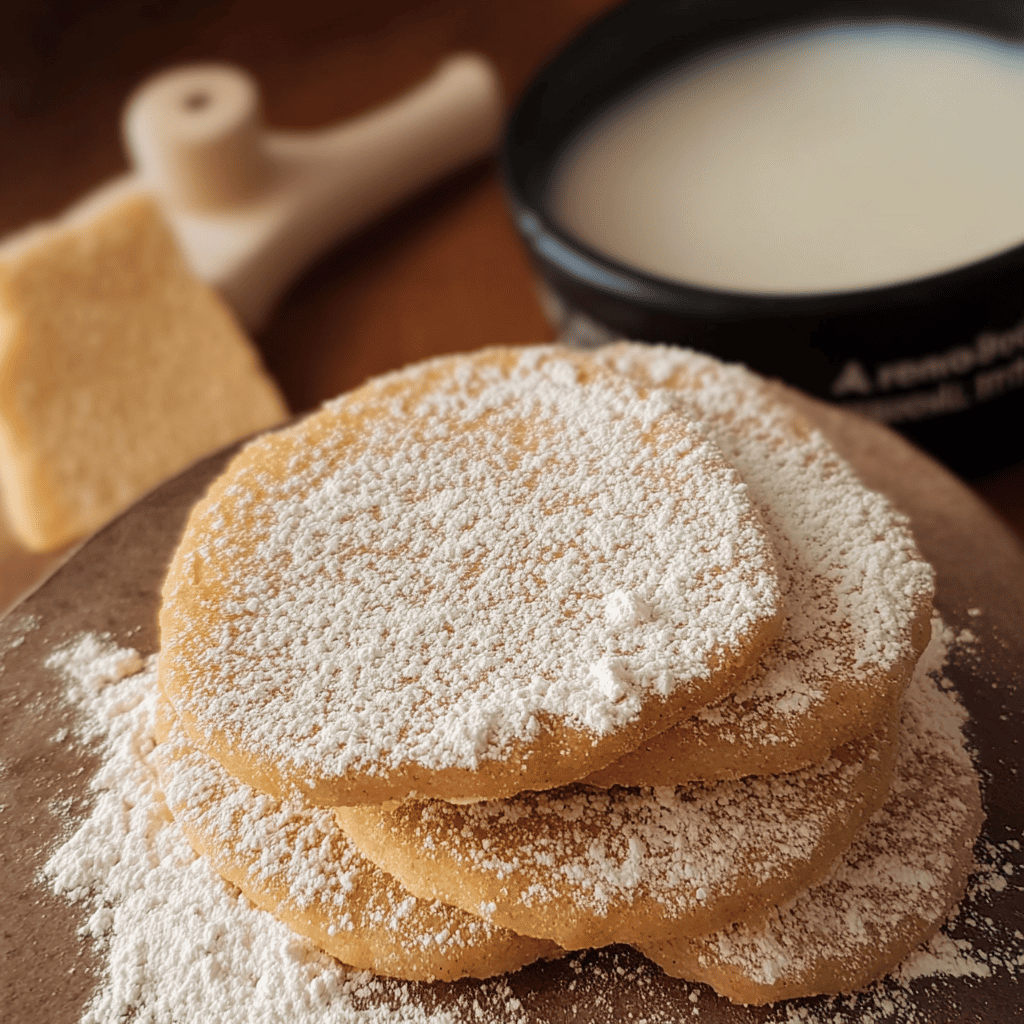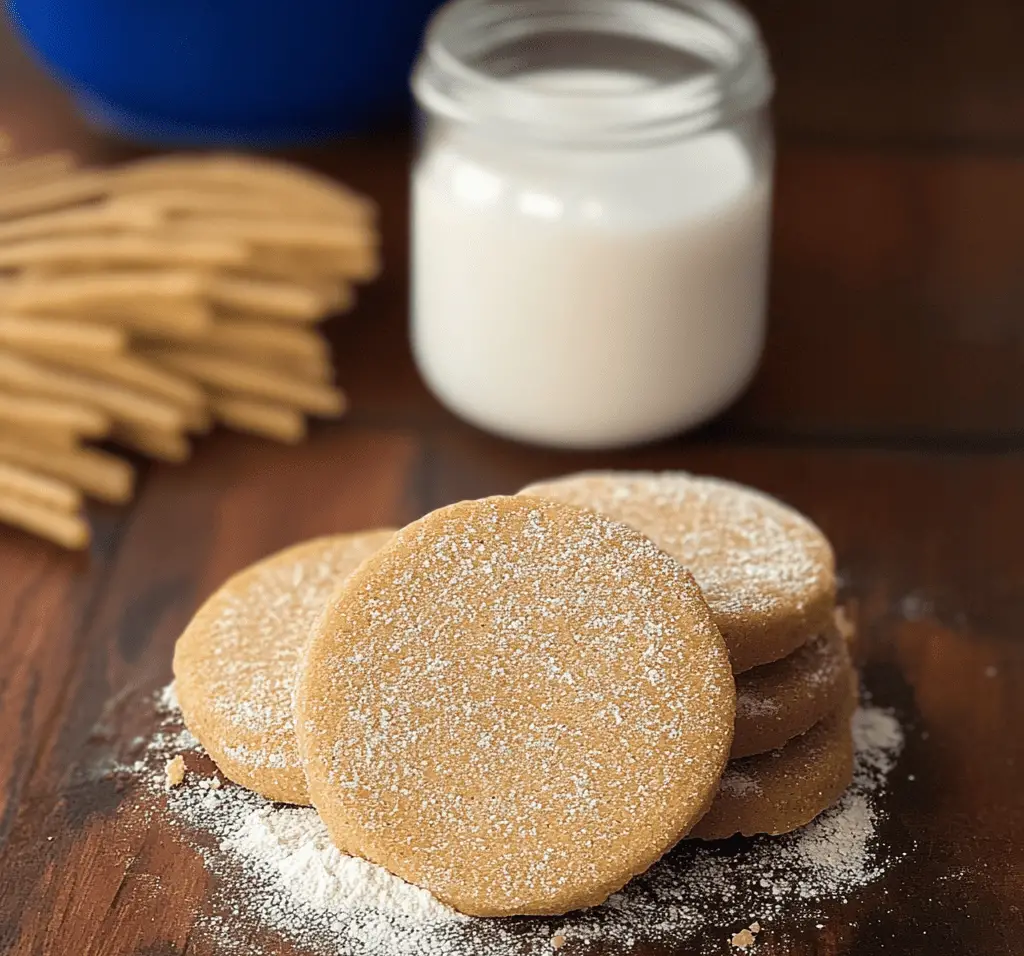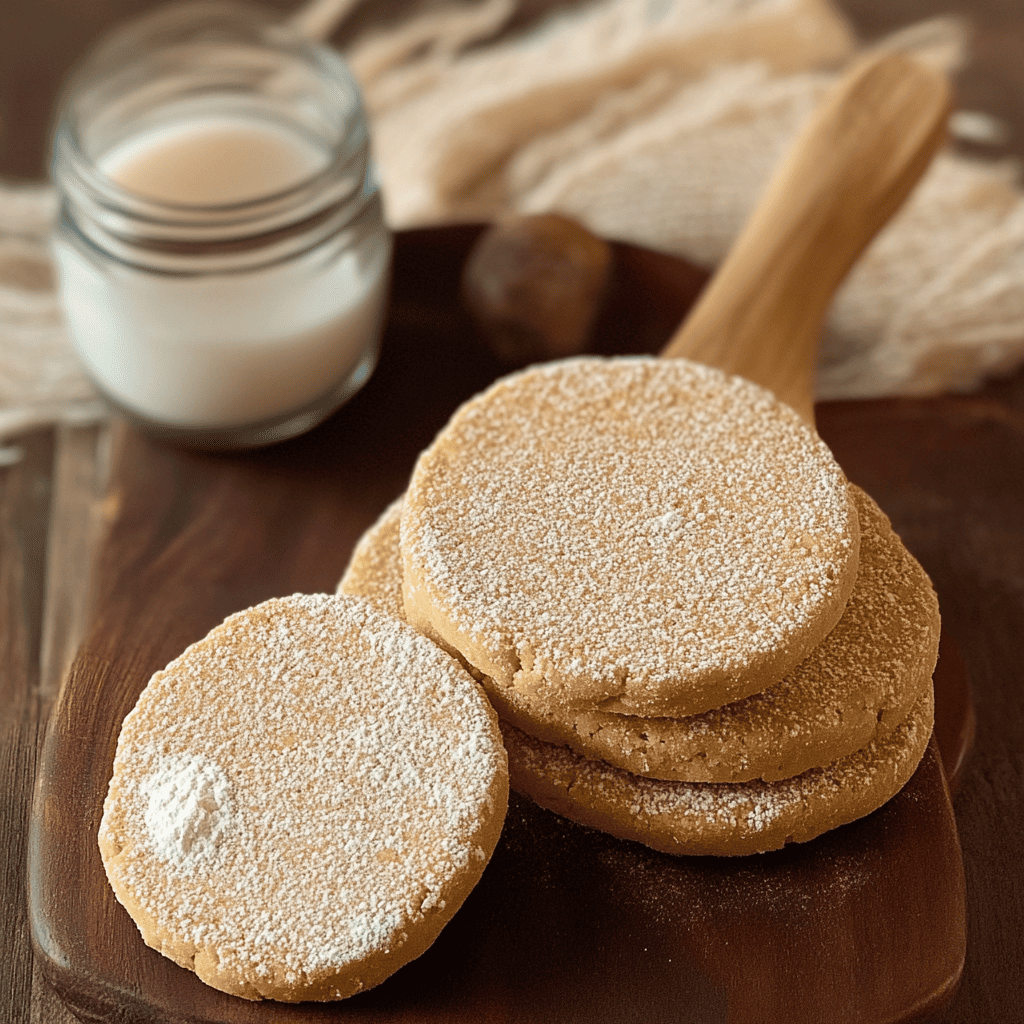Crispy Hojarascas: The Flavor of Tradition in Every Bite
Introduction: A Timeless Classic That Evokes Memories
“Crispy Hojarascas” are much more than simple cookies; they are a true emblem of traditional pastry in various cultures, especially in Mexico, where they are often known as “Cinnamon Hojarascas” or “Wedding Cookies.” Their name evokes their main characteristic: a wonderfully crisp and crumbly texture that melts in the mouth, like dried autumn leaves. These delicate cookies, infused with the warm aroma of cinnamon and a subtle sweetness, are the perfect accompaniment to steaming coffee, hot chocolate, or simply to enjoy on their own. Their simple ingredients and process hide an explosion of flavor and an addictive texture that makes them a nostalgic and comforting snack, ideal for sharing on any occasion or enjoying in the comfort of your home.
Detailed History: Culinary Roots and Evolution of Hojarascas
The history of hojarascas, like many traditional sweets, is intertwined with the culinary traditions of different regions and eras. While there is no single documented origin, these cookies are part of a broader category of “manteca cookies” or “polvorones” that have deep roots in Spanish pastry making. With the arrival of the Spanish in the Americas, these recipes were fused with local ingredients and techniques, giving rise to variations adapted to new flavors and resources.
In Mexico, hojarascas have become a very popular traditional sweet, especially in the north of the country. They are characterized by their uniquely crumbly texture, achieved by mixing fat (vegetable shortening or butter) with flour to prevent the development of gluten, resulting in a “sandy” dough. Unlike other types of cookies, hojarascas are not intended to be chewy or elastic, but rather to break easily.
Cinnamon is a distinctive and essential ingredient in hojarascas, providing that warm, spicy aroma that makes them so memorable. Traditionally, they were a homemade dessert prepared for parties, celebrations, and, notably, weddings, hence their nickname in some regions as “wedding cookies.” They were a symbol of abundance and joy, served to guests as a token of hospitality. The final layer of cinnamon sugar, sprinkled over the still-warm cookies, not only intensifies the flavor and sweetness but also creates a slightly grainy surface that is part of their charm and unique texture.
Over time, the recipe has been passed down from generation to generation, with small family variations that enrich its diversity. However, the essence of hojarasca remains: a simple, honest, and deliciously crunchy cookie that remains a favorite in homes and bakeries, evoking childhood memories and the authentic flavors of the cuisine of yesteryear.
More Details of the Story: The Legacy of Butter and Cinnamon
The choice of fat in shortening is a key element in its history and flavor. The traditional recipe often specifies “vegetable shortening,” which is a fat that is solid at room temperature. The use of shortening, instead of butter, in some variations contributes to an even more crumbly and “sandy” texture in the final product, as it has a higher melting point and doesn’t contain water like butter. However, butter is also a popular choice, providing a richer, milkier flavor. Both options result in a delicious cookie.
Cinnamon, for its part, is a spice with a millennia-long history. Native to Sri Lanka, it has been valued since ancient times for its distinctive aroma and flavor, making it one of the most coveted spices in the trade. Its presence in cinnamon not only provides aromatic warmth but also speaks to the influence of spices on global baking. The technique of mixing cinnamon with sugar to sprinkle warm cookies ensures that the flavor adheres and intensifies as the sugar melts lightly on the warm surface.
The process of “obtaining a sandy texture” by mixing fat with flour is fundamental in the preparation of hojarascas and other similar sweets such as polvorones. This technique, known as “sandying” or “rubbing in” in baking, involves rubbing cold fat into flour until the mixture resembles breadcrumbs or coarse sand. This coats the flour particles with fat, which inhibits the development of gluten when liquid is added, resulting in a cookie that is not elastic but rather brittle and tender.
In short, hojarascas are a perfect example of how basic ingredients and simple techniques can create a dessert with unparalleled depth of flavor and texture, a true legacy of culinary traditions that continues to delight palates.

Ingredients: Simplicity that Captivates the Palate
- 500 g of wheat flour (all purpose)
- 200g shortening or butter (unsalted, at room temperature, if using butter)
- 1 1/2 cups sugar (divided for batter and dusting)
- 2 teaspoons ground cinnamon (divided for the dough and for dusting)
- 1 teaspoon baking powder
- ½ cup of milk or warm water (or the amount needed, just to bind the dough)
- 1 pinch of salt
Detailed Preparation: The Art of the Brittle Cookie
Step 1: Preparing the Oven and Dry Ingredients
- Preheat the Oven: Preheat your oven to 180°C (350°F). This ensures the oven is at the correct temperature when the cookies are ready to go in.
- Dry Ingredients Mixture: In a large bowl, combine the wheat flour, baking powder, one teaspoon of ground cinnamon (the other teaspoon will be reserved for the final sugar and cinnamon mixture), and a pinch of salt. Using a whisk or fork, mix these dry ingredients well so they are evenly distributed.
Step 2: Incorporating the Fat
- Add the Fat: Add the 200g of vegetable shortening or softened butter (if using butter, make sure it’s at room temperature and cut into small cubes for easy mixing) to the bowl with the dry ingredients.
- “Sandy” Mixture: With clean hands (or a pastry cutter), begin crumbling the shortening or butter into the flour. Rub the fat between your fingers and the flour until the mixture takes on a sandy texture, like breadcrumbs. It’s crucial that no large chunks of fat remain.
Step 3: Form the Dough
- Add Sugar: Add 1 cup of sugar (the remaining 1/2 cup will be reserved for sprinkling at the end) to the sandy mixture and mix well.
- Add the Liquid: Gradually add the milk or warm water, a tablespoon at a time, while gently kneading. The goal is to bring the dough together until it forms a soft, manageable ball that doesn’t stick to your hands. The amount of liquid can vary, so add only enough to help the dough come together. Don’t overknead, as this will develop the gluten and make the cookies less crumbly.
Step 4: Roll out and cut the cookies
- Flour the Surface: Lightly dust a clean surface with flour.
- Roll Out the Dough: Using a rolling pin, roll out the dough on a floured surface until it’s evenly thick, about 5 mm (about 1/4 inch). If the dough sticks, you can lightly flour the rolling pin.
- Cut the Cookies: Using a round cookie cutter (or the rim of a glass), cut out the pastry. Gather the dough scraps, gently fold them together without over-kneading, roll out again, and cut more cookies until all the dough is used.
- Place on the Sheet Pan: Place the cut cookies on an ungreased baking sheet. It’s not necessary to grease the sheet pan because the cookies contain enough fat.
Step 5: Bake
- Bake: Place the tray with the puff pastry in the preheated oven.
- Baking Time: Bake for 15-20 minutes, or until the edges of the cookies are lightly golden and the centers are cooked. The puff pastry should be cooked until firm, but not overly browned, to maintain its tenderness.
Step 6: Sugar and Cool
- Prepare the Cinnamon Sugar Mixture: While the cookies are baking, mix the remaining 1/2 cup of sugar with the remaining teaspoon of ground cinnamon in a shallow dish or bowl.
- Hot Sprinkles: Once the puff pastries are out of the oven, and while they’re still warm (this is crucial for the sugar to adhere well), roll each cookie in the cinnamon-sugar mixture, coating both sides. You can also sprinkle them if you prefer.
- Cool: Place the sugared puff pastry on a wire rack to cool completely. They will become crispier as they cool.
- Enjoy! Once cooled, you can enjoy your crispy puff pastries with coffee, hot chocolate, or your favorite beverage.
Estimated Preparation Time
- Active Preparation: 20-30 minutes
- Oven cooking: 15-20 minutes
- Estimated Total Time: 35-50 minutes
Additional Tips for Perfect Leaf Litter
- Cold Shortening or Butter: For a more crumbly texture, especially if using butter, make sure it’s cold and cut into small cubes when mixing it with the flour. This helps create that desired sandy texture.
- Don’t Overknead: This is a critical point. Overkneading develops gluten in the flour, resulting in tough cookies instead of crumbly ones. Mix only until the dough comes together.
- Uniform Thickness: When rolling out your dough, try to keep it to a uniform thickness so that all the cookies bake evenly.
- Sugar and Cinnamon Mixture: Be sure to sprinkle or roll the husks in the sugar and cinnamon mixture while they’re still warm. The residual heat helps the sugar adhere and dissolve slightly, forming a delicious coating.
- Storage: Store the leaves in an airtight container at room temperature. They’ll stay fresh and crisp for several weeks.

Frequently Asked Questions and Clear Answers
- Can I substitute vegetable shortening for oil? It’s not recommended. Oil doesn’t have the same consistency and properties as lard or butter, which would drastically affect the crisp texture of the puff pastry.
- Can I use less sugar? Yes, you can adjust the amount of sugar in the dough to your liking. However, the sugar in the final sprinkle is important for the texture and distinctive flavor.
- How do I know if they’re baked properly? The puff pastry should be lightly browned around the edges and firm to the touch. If it browns too much, it may become tough.
- Can you freeze baked dough or cookies? Yes, you can freeze raw dough wrapped in plastic wrap for up to a month. You can also freeze baked and cooled cookies in an airtight container for up to two months. To enjoy, thaw at room temperature.
- What does “sandy texture” mean? It means the fat has broken down and integrated with the flour into small particles, preventing the gluten from developing and resulting in a cookie that melts easily in the mouth.
Texture and Flavor: A Crispy and Comforting Experience
- Texture: The main characteristic of hojarascas is their incredibly crunchy and crumbly texture . They melt in your mouth with each bite, almost like fine sand, leaving a delicate and satisfying sensation. The sugar crystals on the surface add an extra crunch and a pleasant grainy texture.
- Flavor: The flavor is sweet and warm , dominated by the unmistakable presence of cinnamon. The cookie base has a soft, light buttery flavor, allowing the cinnamon flavor to shine through. It’s a comforting flavor, reminiscent of traditional homemade baking, perfect for pairing with hot beverages.
Consumption Context: When to Enjoy Your Hojarascas?
Leaf litter is versatile and perfect for a variety of occasions:
- Drink Accompaniment: Ideal to enjoy with coffee, tea, hot chocolate or milk.
- Snack or Breakfast: A sweet and light bite to start the day or enjoy in the mid-afternoon.
- Homemade Dessert: A simple dessert for after meals.
- Celebrations and Parties: Perfect for dessert tables at family gatherings, weddings, or special events.
- Homemade Gift: They make an excellent handmade gift, presented in a pretty box or bag.
- Sweet Craving: Simply for when you’re craving a sweet, crunchy cookie.
Visual Aspect: Simplicity and Golden Beauty
The image of the crispy leaves is very evocative:
- Classic Round Shape: The biscuits have a uniform round shape, giving them a neat and traditional look.
- Soft Golden Color: The light golden color of the cookies suggests perfect baking and a tender texture.
- Cinnamon Sugar Coating: The visible layer of granulated sugar with cinnamon on the surface is very attractive, showing the crunchy texture and added sweetness.
- Brittle Texture: Although you can’t feel it, the appearance of the cookies suggests their brittle and delicate nature.
- Appetizing Presentation: Stacked on baking paper, the cookies look inviting and ready to be enjoyed, highlighting the simplicity of homemade preparation.
Curiosities: Interesting Facts about the Ingredients
- Baking Powder: Unlike yeast, baking powder is a chemical leavening agent that doesn’t require standing time for fermentation. It’s activated by moisture and heat.
- Vegetable Shortening vs. Butter: Vegetable shortening is hydrogenated fat, while butter is milk fat. Both have their own properties and uses in baking, influencing the final texture of the product.
- Salt in Sweets: Although it may seem contradictory, a pinch of salt in sweet recipes is essential to enhance flavors and prevent the sweetness from becoming cloying, creating balance.
- Origins of Cinnamon: It is one of the oldest known spices, valued for its sweet and spicy aroma, which is obtained from the bark of trees of the Cinnamomum family .
Nutritional Value (Estimated per Unit)
The nutritional value of puff pastry can vary depending on the size of the cookie and the exact amount of ingredients. For a medium-sized cookie (approximately 30-40g):
- Calories: 120-180 kcal
- Protein: 1-2g
- Total Fat: 6-10g (from butter)
- Carbohydrates: 15-25g (from flour and sugar)
- Fiber: <1g
- Sugars: 8-15g (added sugar)
- Sodium: 30-60mg
Additional Benefits and Interesting Facts
- Long-lasting: Thanks to their low moisture content, leaf litter keeps well for a long time, making them ideal to always have on hand.
- Irresistible Aroma: The aroma of cinnamon that fills the kitchen during baking is one of the most pleasant experiences of this recipe.
- Easy to Transport: These are sturdy crackers that transport well without breaking easily, making them ideal for picnics or as part of a packed lunch.
- Versatility: They can be customized with other spices like nutmeg or ginger, or even add a little orange or lemon zest to the dough.
Other Information
- Allergies: This recipe contains gluten (flour) and possibly dairy (if butter or milk is used).
- Family Preparation: The simplicity of the recipe makes it ideal for getting children involved in the cooking, especially in cutting the cookies and sprinkling them with sugar and cinnamon.

Conclusion: A Sensory Journey to Authentic Pastries
Crispy Hojarascas are a pastry treasure that delights with their simplicity and profound flavor. Each bite is a journey through the warmth of cinnamon and the delicacy of a cookie that melts in your mouth, evoking memories of home and tradition. This recipe invites you to recreate that magic in your own kitchen, offering a sweet pleasure that is both comforting and addictive. Perfect for any time of day, hojarascas are proof that the most authentic flavors reside in homemade preparation, a culinary legacy that deserves to be shared and enjoyed.

